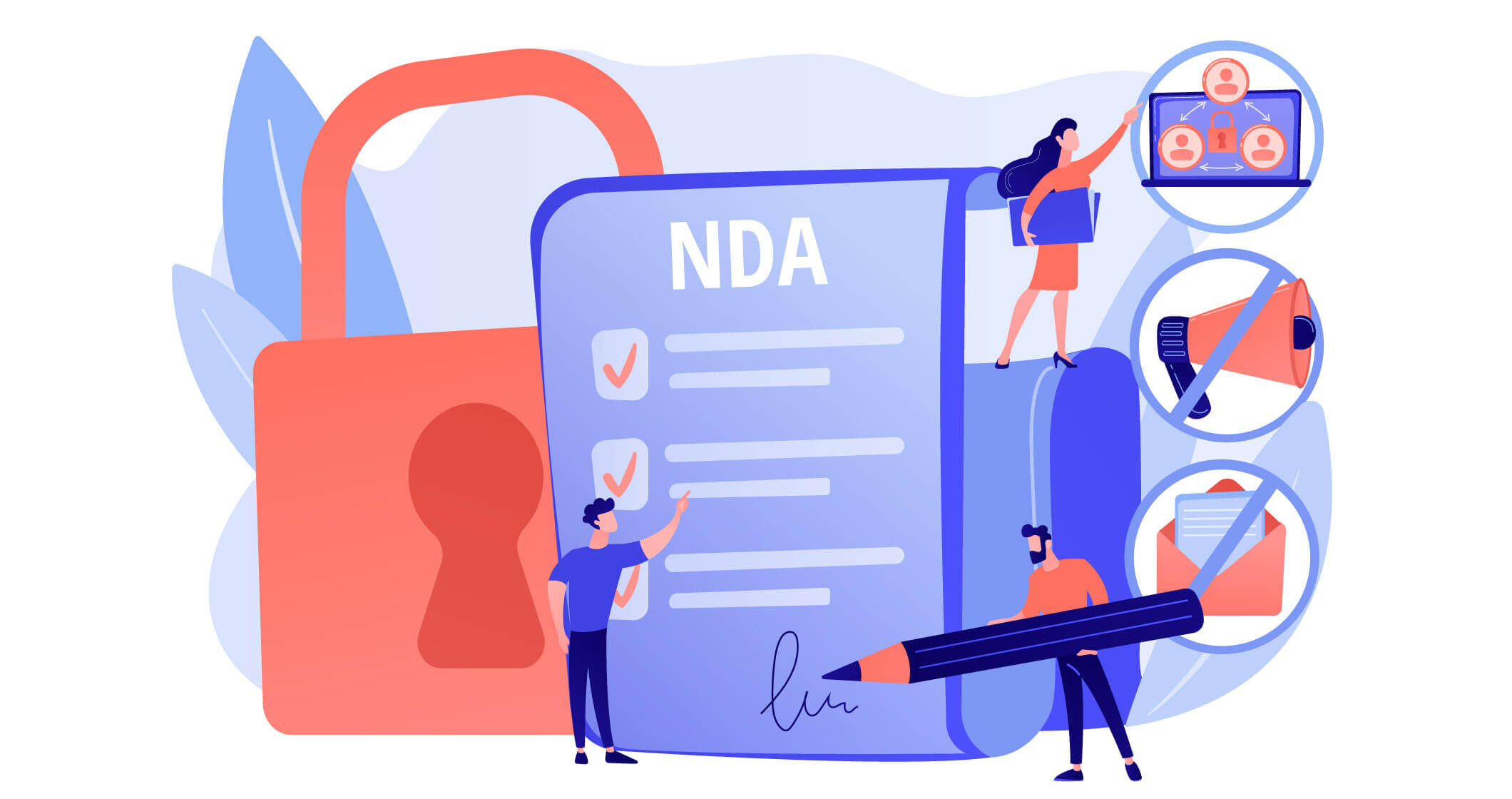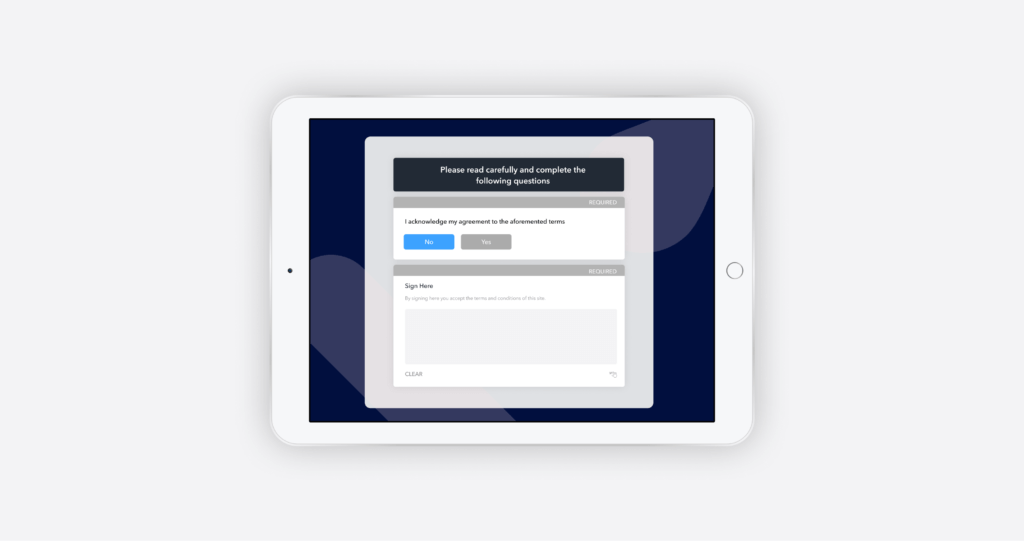
Confidentiality is crucial to businesses, especially those who need to protect certain aspects and information from security breaches. Meaning, NDA considerations commonly need to occur when two parties require the exchange of confidential information. The need for an NDA commonly arises when visitors or contractors need to spend time at an organization’s facilities where they are likely to come into contact with confidential information not known to the general public.
One way to guarantee this privacy is by asking all employees and relevant parties involved in business processes and development of new products to sign a non-disclosure agreement or an NDA.
In this guide, we answer:
so that you can make sure you have all of your bases covered when the time comes for your business.

NDA stands for Non-Disclosure Agreement. It is a confidentiality agreement that’s main goal is to protect the specified information that is shared between parties.
NDA’s are created by a lawyer for each of the transactions required between a business and another party. They are each customized to the discussion at hand and are signed by each party to protect anything that is confidential in nature.
It’s common for the signing of an NDA to be the first step in business contracts, as they seek to cover each of the complexities of their business transaction.
Aside from keeping company intellectual property a secret, NDAs can also work to keep businesses and workplace activities safe.
An example of this is requiring contractors and security teams to sign an NDA to prevent disclosure of a workplace's layout or how security sweeps are undertaken. With this in mind, a firm can rest assured that their own unique way of keeping on top of workplace safety is protected and that no one can sneak by a sweep or enter an emergency exit.
The protection of intellectual property may also be a factor in keeping a workplace safe, too.
A company that requires all entering parties to sign an NDA will restrict any conversations regarding the products or developments inside happening outside of the workplace — thus reducing the chance of information leaks and break-ins by thieves wanting to access products in development.
An example of this is Apple's development of the original iPhone. All parties involved were reportedly required to sign dual-NDAs. The first NDA restricted all parties from discussing the second NDA, and the second NDA was concerning the iPhone's development. Apple supposedly undertook such pedantic measures to reduce both the chance of a copycat device and the chance of burglary. As you can see, there are a few ways an NDA can help to secure a workplace
In order to make sure that you have covered all NDA considerations, you should ensure that the document includes each of the following elements.
The description of purpose in your NDA is important because it tells you about the specific reasons for the recipient that they may use the confidential information being discussed.
Without this, a recipient may use confidential information to their advantage in other ways.
This is where you can clearly define exactly what it is you’re declaring as confidential. It’s important to be very specific in this section as a court could void the entire agreement if the information provided is too vague.
NDA’s are never a copy and paste type of document. They should always be tailored to your specific business.
Be as descriptive as possible without revealing too much about the information you want to protect through the NDA. If the description is too general, it will be difficult for the court to enforce the NDA.
The restricted use section of the NDA addresses issues such as the recipient actually being a company, or cases where the recipient will need to share the NDA with their lawyer for review.
Limiting the use of the information provided in your NDA is in your best interest, so you can use this section to properly define these limits.
Whoever the information is disclosed to by the recipient, should also sign an NDA agreeing to the same terms.
It will be important to be specific about how long the NDA will last. The term of your agreement section is where you will define this.
Generally, an NDA lasts longer than a given transaction or relationship. You will want to include a provision that states the disclosure must remain protected even after the deal has been closed or the business relationship ended.
In order for the NDA to be valid, it will require consideration. Situations that would mean for consideration are the merging of companies, or if you’re to do something like offering employment in consideration for the employee.
New considerations may need to be made if certain scenarios require it.
Once you and your lawyer have gone through the NDA to make sure it meets all of the requirements, you will need to put a process in place for collection and storage.
Sine makes this process easy as visitors can sign the NDA as a part of their entry procedure. Any required documentation will be presented to them through their device as they are signing in at your facility. This process is easily completed either at or before entry.
Once the NDA has been signed through our contactless app, it can be securely stored within the cloud. You can access these records at any time and have peace of mind in knowing that they are only accessible to you.

For years, many companies across all businesses have been searching for an NDA solution that's designed for the ways they work — digitally.
Today, Sine offers a suite of features that include the ability to create, distribute, and receive NDAs from clients, customers, and business partners. All NDAs provided with Sine can be entirely customised to a business's content and can be adapted to the types of visitors signing them, ensuring that no information is accidentally shared to the incorrect party via an NDA.
All NDAs sent with Sine are:
In a single tap, your business could quickly relay numerous, unique NDAs to all relevant parties and their devices with the Sine app installed. To improve upon this, through the use of geofencing businesses can instantly have NDAs shared to every relevant party the moment they arrive on premises.
There's no need for an outside-of-work meeting, or to deliver paper documents, the Sine app simply does it all for you.
Here are the two ways modern NDAs work with Sine;
OR,
Making use of Sine's diverse, location-based services you're able to effectively send and receive signed NDAs as well as have all of the documentation provided to parties your business's entry point, effectively automating the entire NDA-signing procedure.
Header art: Abstract vector created by vectorjuice - www.freepik.com